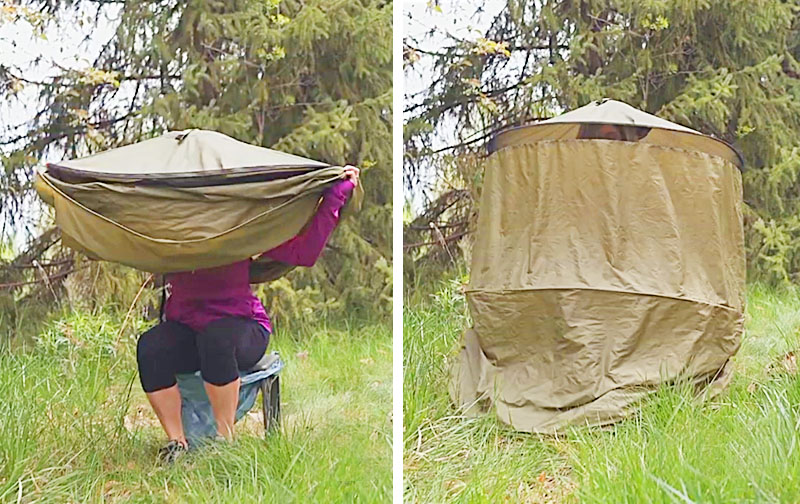One final word please: There have been many responses, some quite insensitive to one's bodily needs along the Way. Let's face it--it's much easier to be a guy on the walk. All you do, which I have plainly see along the way, is turn your back and pee in a bush. At least you could be a bit more discreet and go behind a tree so people can't see you! For us women, it's not the easy! No one wants to make the Camino like Disneyland! I too was frustrated walking the last 100 kilometers with all the Camino tours. I'm not a person who just showed up at the 100 kilometer marker, stayed at 5 star hotels and has my pack shipped ahead of me. I walk with the intention of experiencing the true Camino as best as I can...in the 21 century. I'm not here to judge or to criticize other people, their resources, other countries, their culture... or the Way. I'm just trying to make a few constructive suggestions on how the walk could be protected the Way from human waste and waste litter with the millions and millions of people who walk it each year! Let's face it, people need to use the restroom/Water Closet during the walk. Now, I am speaking about the newest route, the Portuguese Coastal Route. In the 12 century, they probably didn't have millions and millions of people walking it each year on the various routes. Things are much different now in the 21 century, thus changes should be made, made to help protect the land and to address the necessary needs.
May I also suggest the following as a way to organize and fund the Way including the trail, the boardwalks, rest rooms... As a Pilgrim planning to return to walk another Camino in the near future, I would be glad to give $5 to help support building & maintaining WCs along the routes when I purchase my passport. So, who would be in charge of the accumulated funds? Now, I know a number of people dislike the America. I get it, at times I'm even frustrated with the America. Even more so now but, in the States, we really do have some great ideas which turn into projects, then programs, volunteer programs, and non for profit organizations... to help support Parks, the many Trails...where millions of people around the world do visit!
For example, in the States, the Appalachian Trail, is the longest hiking-only footpath in the world, measuring roughly 2,190 miles (3524.463 kilometers) in length. The Trail travels through fourteen states, from south to north, and is served by all volunteers, by The
Appalachian Trail Conservancy, which is composed of 31 Trail Maintaining Clubs, which are responsible for most of the day-to-day work of keeping the A.T. open. In addition to Trail maintenance, club volunteers in Trail Crews, build and repair shelters and other structures, monitor and protect the Trail corridor, monitor and manage rare plants and invasive species, develop management plans for their sections, and much more. The ATC is largely funded by its more than 42,000 members and over 600,000 supporters located throughout all 50 states and in more than 15 countries. It has an main office and an all-volunteer staff in Washington, D.C., which has managed the organization for its first four decades. With central offices in Harpers Ferry, West Virginia. They work in cooperation between ATC, A.T. Clubs, A.T. Communities and government agencies as well as among staff members, volunteers, and our key constituencies. "We respect each other and work openly together to achieve our common objectives and support our mission. Surprisingly, the ATC today has only a governing body of 15 volunteers, over 43,000 individual members, an annual budget of $9.36 million, a full-time staff of about 60 in six locations (along with more than a dozen part-time and seasonal employees), and total assets of about $17 million, including about 40 properties along the Trail." "
Our mission is to is to preserve and manage the Appalachian Trail – ensuring that its vast natural beauty and priceless cultural heritage can be shared and enjoyed today, tomorrow, and for centuries to come."
Then there is a Continental Divide Trail Coalition, the CDT. "The Continental Divide Trail Coalition’s vision is to see that the 3,100-mile Continental Divide National Scenic Trail (CDT) is a renowned and revered natural resource for people to connect with friends and family, draw inspiration, and create outstanding personal experiences. We see the CDT as a world-class national resource that inspires pride, passion, respect, creativity, community and perseverance. The CDTC was founded in 2012 by volunteers and recreationists hoping to provide a unified voice for the Trail. Today, CDTC is a robust 501(c)3 organization that works hand-in-hand with the U.S. Forest Service and other federal land management agencies to build a strong community of supporters who want to see the CDT protected not just for today’s users, but for generations to come."
https://continentaldividetrail.org/about-cdtc/
Then, there is The Pacific Crest Trail Association, "an eclectic band of trail junkies, who champion the needs of the Pacific Crest Trail. From across the country and the world, our team travels throughout the mountain ranges of the American West to support the much larger PCT community in protecting, preserving and promoting the trail. We’re committed to the idea that by supporting our members, volunteers, partners and donors, we’ll succeed in safeguarding this National Scenic Trail for the benefit of future generations. We are the Pacific Crest Trail!" They, groups of volunteers, band together to maintain the trail from Mexico to Canada." "The Pacific Crest Trail Association is singularly focused on keeping the PCT open for generations to come. We are headquartered in Sacramento, Calif., and our staff—which includes regional representatives in Washington, Oregon and California—works with thousands of volunteers and donors to protect, preserve and promote one of the best trail experiences on Earth. We are the eyes, ears and voice for the trail."
https://www.pcta.org/our-work/
In other smaller National Parks, there are "Friends of the Smokies" for example, which is a non profit organization. They have a Board of Directors, a staff and volunteers, which supports the National Park Service’s mission of preserving the Great Smoky Mountains by raising funds and recruiting volunteers who help repair the trails. “Friends” are always soliciting contributions to help fund repair work on trails, wildlife research and protection, environmental educational services.
https://friendsofthesmokies.org/the-park/
In regards to the ATC: Our Values:
The Appalachian Trail Conservancy is guided by a set of staff core values that represent the organization’s commitment to preserve and manage the Appalachian Trail. We pursue our mission and vision by our dedication to: Cooperation: The A.T. could not exist without cooperation: cooperation between ATC, A.T. Clubs, A.T. Communities and government agencies as well as among staff members, volunteers, and our key constituencies. We respect each other and work openly together to achieve our common objectives and support our mission.
Integrity: We conduct ourselves in accordance with the highest standards of professional and personal behavior and ethics. We are transparent, honest and ethical in all our interactions with each other as well as with our partners and all those we encounter in the broader A.T. community.
Inclusion: ATC aspires to be a welcoming and diverse organization that attracts, retains, and values talented people from all backgrounds. We appreciate differences in one another as well as our similarities. We strive for this spirit of inclusivity to expand beyond our organization and especially to our government and volunteer partners.
Dedication: ATC staff members are passionate in their service to the Trail. From the Executive Director to seasonal staff members, in the office or in the field, on the clock and off, we work hard to promote and preserve the A.T. experience we cherish.
Empowerment: We empower our talented staff members to take the initiative to stimulate continuous improvement and positive change in all aspects of the organization."
http://www.appalachiantrail.org/home/about-us/mission-vision-values
There could be a "Friends of the
Camino de Santiago" or the "
Camino de Santiago Conservancy" organization which could do the same as the
Appalachian Trail Conservancy. You can go to the individual websites to see just how well they are organized, like a well oiled machines. They are wonderful guides on how to...and I am sure with phone calls or emails to the right individuals, they could help answer any questions you may have on how to get started with developing such an organization. Don't forget the "Trail Angels," people who live near the trail, who help hikers along the way in various ways. Again, just some suggestions. Afterall, this is the 21 century! Cooperation and organization are keys. In regards to the CDT: "We see the CDT as a world-class national resource that inspires pride, passion, respect, creativity, community and perseverance. While we are extremely proud of our accomplishments to date, we realize that there is much more to be done to fulfill our vision for the future. We want to protect the Trail’s wealth of natural and scenic resources, build a sense of community, promote public land stewardship, inspire healthy lifestyles, and above all, encourage people to know, use, and care for the CDT."
Again, just some suggestions... Buen Camino!


 www.thesuperboo.com
www.thesuperboo.com





























